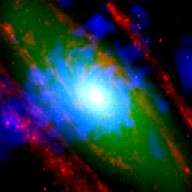Gone With the Galactic Wind: 10 Years of Chandra X-ray Observations Reveal Galaxy Secrets

(PhysOrg.com) -- When NASA launched its Chandra X-ray observing telescope into orbit in 1999, astronomers didn’t know much about the galactic winds made of wispy, multi-million-degree gas clouds that stream out from normal galaxies like our own, because they are “diffuse, gentle and unspectacular” compared to far more dramatic emanations of starbursts, recalls astronomer Q. Daniel Wang of the University of Massachusetts Amherst.
But direct observation by the Chandra orbiting telescope have changed all that and led to “the first characterization of the spatial, thermal, chemical and kinetic properties of the gas in our galaxy,” Wang states. Chandra data show, among other things, that though seemingly as ephemeral as fog, the outflowing hot gas from normal galaxies exerts a very powerful feedback force on the surroundings, preventing or slowing the infall of intergalactic gas due to gravity. “This discovery is a new key to our understanding of how galaxies work, especially how they lose mass and energy, that was not possible before Chandra,” he adds.
The astronomer catalogs the new knowledge in an article published this week in the early online edition of Proceedings of the National Academy of Sciences. Because his group has made extensive use of Chandra data, he was asked to write a review celebrating the instrument’s 10-year anniversary.
As Wang explains, galaxies like our own are made of visible stars and gas but investigating this matter and its properties using only visible light reveals only a small fraction of material actually present. “The hot gas is very hard to detect because of its low density, hence weak radiation, compared to black holes and neutron stars that accrete from their companions, which tend to overwhelm X-ray emissions from a galaxy,” he adds.
“By X-raying galaxies, we can see the invisible, and with the Chandra instrument we can detect gas that emits or absorbs X-rays, as well as such exotic objects as black holes and neutron stars that tend to emit primarily in X-rays.” X-ray tomography by the high-spectral resolution Chandra instrument has given astronomers the unprecedented opportunity to examine the amount, distribution and composition of the hot gas against bright background sources.
It has also helped to yield clues to the mystery of why there is not enough hot gas present inside or in the immediate vicinity of galaxies as predicted by current theory, in particular elements synthesized and ejected by stars. In fact, says Wang, “we find that the bulk of energy expected from the supernovae is missing as well. We conclude that this missing energy is gone with the wind, a galactic wind that blows matter to much larger regions around galaxies than previously understood.”
“Indeed, we find direct evidence for such winds and outflows in nearby galaxies. This uses another well-known capability of the Chandra, the exquisite spatial resolution, which allows us to detect discrete X-ray sources and to remove them cleanly when mapping X-ray emission in and around galaxies. The outflows are called galactic feedback, which can have profound impact on the ecosystem of the galaxies.”
“These results, compared with detailed simulations, now enable us to study how the feedback regulates the formation and evolution of galaxies,” Wang says.
Provided by University of Massachusetts Amherst



















